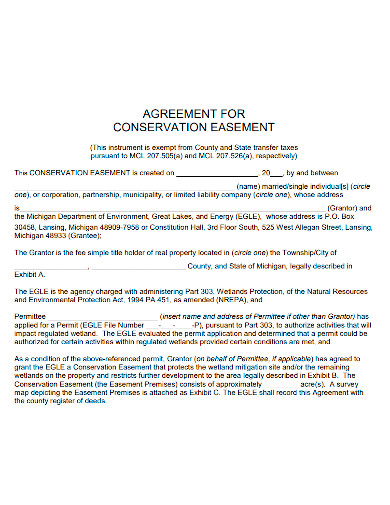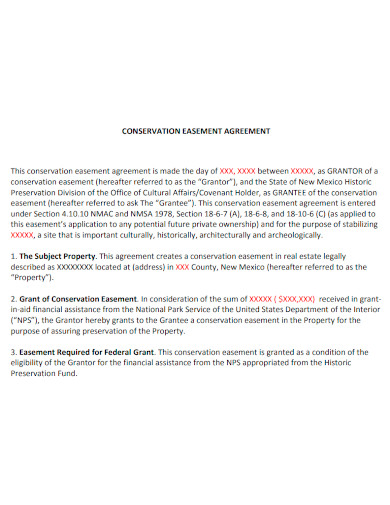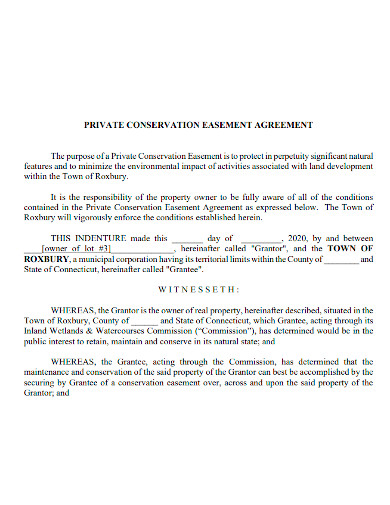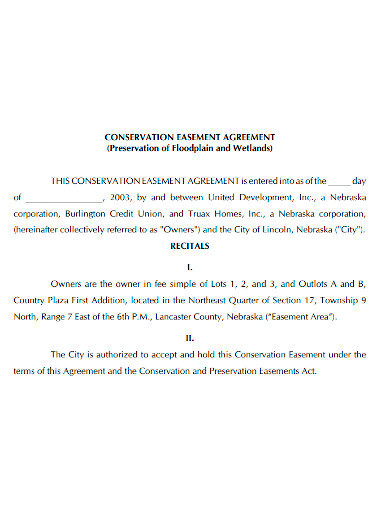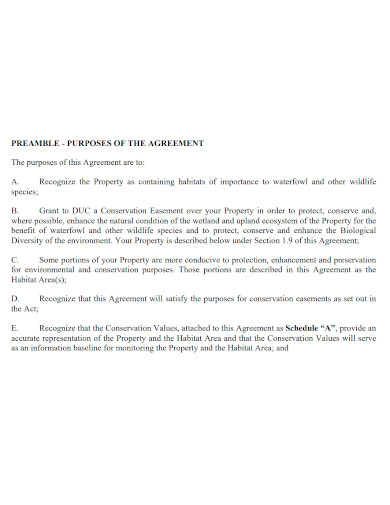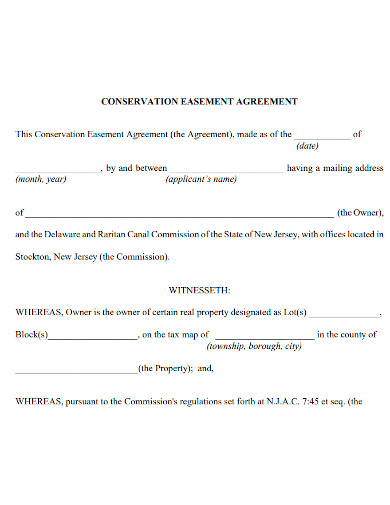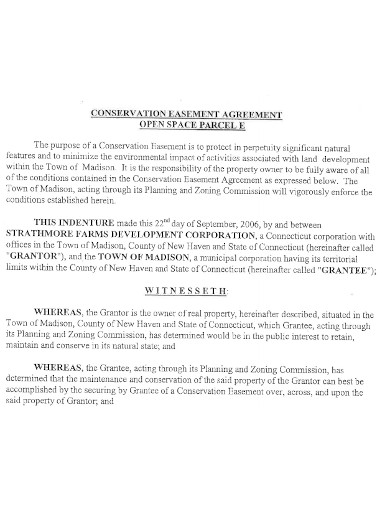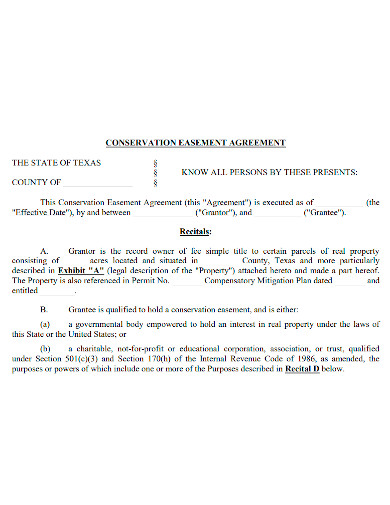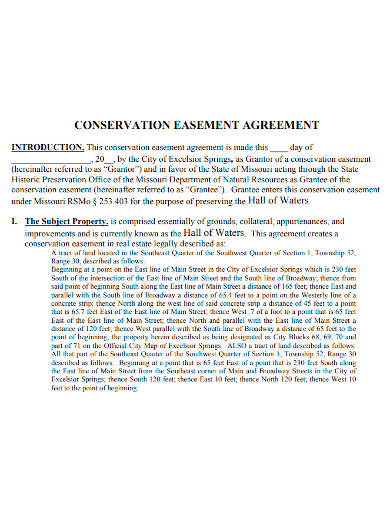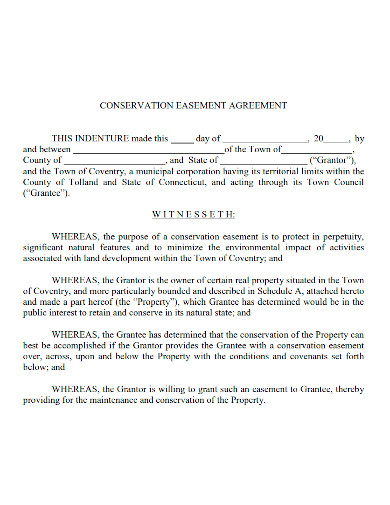10+ Conservation Easement Agreement Samples
In land conservation work, some properties are purchased outright, in which case ownership changes. These types of purchases are referred to as fee simple or fee title acquisitions. Other properties conserved with funding by our grant programs, however, do not involve a change in ownership; they are protected by a conservation easement held by a nonprofit land trust organization or local government. With the importance of this matter, it would be rightful enough to secure a Conservation Easement Agreement. In making this possible without doing it from the very scratch, our site offers you free, available, customizable and ready-made templates that you could use right away for your Conservation Easement Agreement needs. Just browse among these templates and choose the one that satisfies your needs the most.
For other agreement templates, our site is offering you these agreement templates that you can utilize when needed: Employee Equipment Agreement, Vendor Purchase Agreement, Vendor Merchandise Agreement, Vendor Service Agreement, Training Services Agreement, Teacher Agreement, Workshop Service Agreement, Student Teaching Agreement, Product Sales Agreement, Farm Land Lease Agreement, etc. This article will not only give you templates but also necessary information that you need to know for your agreement. So come on, explore this article with me!
1. Conservation Easement Agreement Sample
2. Printable Conservation Easement Agreement
3. Private Conservation Easement Agreement
4. Standard Conservation Easement Agreement
5. Permanent Conservation Easement Agreement
6. Formal Conservation Easement Agreement
7. Conservation Easement Agreement Format
8. General Conservation Easement Agreement
9. Professional Conservation Easement Agreement
10. Editable Conservation Easement Agreement
11. Basic Conservation Easement Agreement
What Is A Conservation Easement?
It’s a voluntary legal agreement between a landowner and another entity (usually a land trust) that places restrictions on the use of a piece of property. Conservation easements, restrict those uses forever, permanently conserving the property. Common examples of use restrictions include prohibiting building on the property or preventing mining on the property. That said, landowners retain many of their rights, including the right to use the land (for purposes such as agriculture) and to sell it or pass it on to their heirs. Conservation easements are beneficial because they protect properties with unique conservation values, like farms and ranches that sustain local food supplies and rural economies, and properties that provide wildlife habitat or migration routes, hold water rights that protect water supply and support outdoor recreation, and provide scenic views that attract tourism and outdoor recreation. The work doesn’t stop once the conservation easement is in place. The land trust holding the easement must monitor the property to ensure the landowner is complying with the terms of the agreement, and it has the right to enforce the promises the landowner made.
The Advantages Of Conservation Easement?
very conservation easement is a unique legal agreement, written specifically to fit your needs and goals. You can set up a conservation easement to:
- Protect open space or critical habitat on your land– whether it’s a family farm or ranch, wetland, pasture or forest—from encroaching development
- Preserve the agricultural value and traditional uses of your land by allowing for continued farming, ranching and timber harvesting
- Safeguard a historically or culturally important structure or area on your property
- Conserve land that has significant scenic, biodiversity or other value for the outdoor recreation or education of the public
Whether you place all or only part of your property into a conservation easement, you can expect to benefit from the agreement in several ways.
Estate tax benefits. A conservation easement that removes your land’s development potential typically lowers its market value—and that means lower taxes for the landowner. That can significantly reduce estate taxes when you pass on your property to the next generation, making it easier to keep the land in the family and intact.
Property tax benefits. By lowering your land’s value, a conservation easement can also lower your property taxes.
State and federal tax benefits. If your conservation easement is permanent, was donated—not sold—to a land trust for conservation purposes, and meets certain conditions, it can qualify as a tax-deductible charitable donation that can reduce your state and federal income taxes. The easement is treated as a donation of the development rights to your land. That means the value of the donation (and the amount of the deduction you can claim) would be the difference between the property’s market value if its development were not restricted in any way, and its value with the easement’s restrictions in place.
Permanency and control. Most easements are permanent and crafted specifically to meet your goals. Their restrictions remain in force even when the land changes hands. With the right easement terms in place, you can have the peace of mind of knowing your land will be protected as you wish well beyond your lifetime.
Although conservation easements offer significant benefits, they are not for every landowner. There are some important points to keep in mind when you consider a conservation easement.
FAQs
What is a conservation appeasement on a property?
A conservation easement is a voluntary agreement with a nonprofit land trust or government agency that allows a landowner to limit the type or amount of development on their property while retaining private ownership of the land. When completed, the conservation easement becomes part of the property deed.
What are the disadvantages of conservation easements?
When you create a conservation easement, you may lose access to certain rights. While you’ll likely retain certain surface rights like farming and ranching, development is almost always limited. Furthermore, surface mining is almost always off the table and the goal is to protect the land overall.
Having this document might be a hard task for you especially if you are doing it from scratch so as it needs to consider a lot of legalities that should be in lined with the law.. To avoid this, you are highly encouraged to avail resources that you can see online to make your work, easy, convenient and quality-made. So what are you waiting for? Avail our templates now!
Related Posts
FREE 10+ Trial Agreement Samples In MS Word | Google Docs | Apple Pages | PDF
FREE 9+ Shop Rental Agreement Samples [ Commercial, Lease, Tenancy ]
FREE 10+ Charter Agreement Samples In MS Word | Google Docs | Apple Pages | PDF
FREE 10+ Mentoring Agreement Samples In MS Word | Apple Pages | PDF
FREE 10+ Partner Agreement Samples In MS Word | Google Docs | Apple Pages | PDF
FREE 10+ Individual Agreement Samples In MS Word | Google Docs | Apple Pages | PDF
FREE 10+ Strategic Agreement Samples In MS Word | Google Docs | Apple Pages | PDF
FREE 10+ Equity Agreement Samples In MS Word | Google Docs | Apple Pages | PDF
FREE 10+ Producer Agreement Samples in MS Word | Apple Pages | PDF
FREE 10+ Grant Agreement Samples In MS Word | Apple Pages | PDF
FREE 8+ Meeting Agreement Samples in MS Word | Google Docs | Apple Pages | PDF
FREE 10+ Community Agreement Samples In MS Word | Google Docs | PDF
FREE 8+ Real Estate Option Agreement Samples in MS Word | PDF
FREE 10+ Call Option Agreement Samples In MS Word | PDF
FREE 10+ Advertising Agreement Samples In MS Word | Google Docs | Apple Pages | PDF

